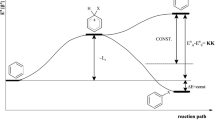Abstract
AN aromatic molecule may be characterized as one which can carry a ring current. This ring current is induced by an external magnetic field and can be observed by means of its large contributions to the anisotropy of both the diamagnetic susceptibility and the chemical shift. There is another observation which can be used for the same purpose and remains valid for radicals and ions. This is the anisotropy of the electronic g-factor. An unpaired electron, in a molecule or radical, has its spin oriented by the magnetic field which it experiences. This field consists of the external field together with the field at the electron due to induced ring currents of the other electrons. Since aromatic rings are usually planar this second field depends on orientation and results in an anisotropy. The g-factor, in this context, measures the ratio of the effective field to the external field.
Similar content being viewed by others
Author information
Authors and Affiliations
Rights and permissions
About this article
Cite this article
HALL, G., HARDISSON, A. Anisotropy of the g-Factor in Aromatic Molecules. Nature 198, 283–284 (1963). https://doi.org/10.1038/198283b0
Issue Date:
DOI: https://doi.org/10.1038/198283b0
- Springer Nature Limited





